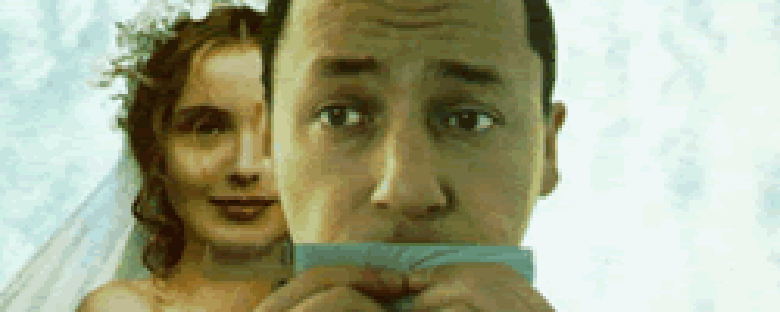Reviews
Trzy kolory: Bialy
Krzysztof Kieslowski
France / Poland, 1994
Credits
Review by Rumsey Taylor
Posted on 11 July 2004
Source VHS
Foremost in viewing White one ponders its relation to Blue, and later Red. White immediately eschews Blue’s thematic standpoint, as the drama that characterizes the latter film is largely absent in the former.
White is similarly dramatic, albeit it is far less impactive than Blue (the film contains moments of ironic comedy). The film’s central character, Karol, loses everything within the film’s first twenty minutes. After becoming divorced from his wife, Karol has his credit card confiscated. The card is blue, and is cut in a foreground action, symbolically denoting that Karol’s liberation has been disenabled; he is temporarily hindered by uncontrollable forces. The metaphoric quality of this action is interpretably a fitting conclusion to the emotional trajectory of Blue.
Broke and unkempt, Karol retreats to a metro station, opens his suitcase to display his diplomas in hairdressing, folds a handkerchief over a comb and begins to hum songs from his native country. If this is not the pinnacle of his travel to humility, then it occurs when a stranger passes by, throws a franc into the case and tells him his fly is open.
The stranger, Mikolaj, and Karol become close, as their companionship is based on a unique sympathy for each other: Karol has lost his marriage and belongings, and thrives, perhaps, on his desire to better his existence. Mikolaj, contrarily, has money and a loving family and is dissatisfied with it all. He wants to die, and in Karol garners an appreciation for what he takes for granted.
The two form a business together (this detail is treated as incident, as the fact that they acquire a great deal of money is the only detail essential to the plot). Karol abominates his poverty, and in his wealth seeks retribution, for his ex-wife to experience the same humiliation. This is the fundamental movement in White, as Karol is seeking equality.
This denotes the underlying approach of the “Three Colors” trilogy. Though the films employ concepts that are collectively understood as emblematic of appreciated human ambitions, the films treat these concepts arbitrarily, if not ironically. Karol seeks equality in his marriage, though his means is less than admirable. Similarly, Julie’s liberation in Blue requires her to disown her previous existence, to hide, to renew herself in anonymity. Neither plot employs the admirable connotation intended in their use in the French flag.
Equality in White is used in the sexual implications of Karol’s marriage; their sex is denotative of their equality. In their divorce trial, Dominique cites his inability to consummate their marriage as ground for her disinterest, and finally their divorce. Karol eventually manages to bed Dominique, and her climax (easily, one of the most powerful orgasms depicted in film) is represented by a brilliant flash of white on screen.
Kieslowski’s accomplished direction is evident at two points in White. Images are interspersed in straightforward sequences that seem unrelated to the scenes in which they occur. The first is the film’s opening: a large suitcase is seen on a conveyor. The action seems parallel to a courtroom scene in which Karol and Dominique’s divorce is cemented. There is no immediate understanding for the image.
Later Karol thinks of his ex-wife, and each time she is seen entering a darkened room. Again, this action is sporadic and unrelated.
Both actions reference scenes that occur later in the film. The scene referenced in the opening is of Karol’s exodus to Poland (broke, he travels in his own suitcase). The images of Dominique occur just prior to the film’s climax. This forward referencing is a technique that broadens the scope of White, and similarly, furthers connections in the “Three Colors” as references between the films are made with the same sporadic quality.
For example, in White’s opening scene the action is interrupted as a woman enters the courtroom from the rear and is promptly escorted out. The woman is Julie, and the scene has also occurred in Blue from another perspective.
The “completeness” of the trilogy becomes evident for the first time in White. Though Blue ends, it lasts in its thematic aims throughout White. The tonal shifts in White display, for the first time, the emotional depth the trilogy enables, and functions secondly to paint expectations for Red. Blue and White are fundamentally different films. Regarding their connection as a trilogy, they will end in Red.
We don’t do comments anymore, but you may contact us here or find us on Twitter or Facebook.



